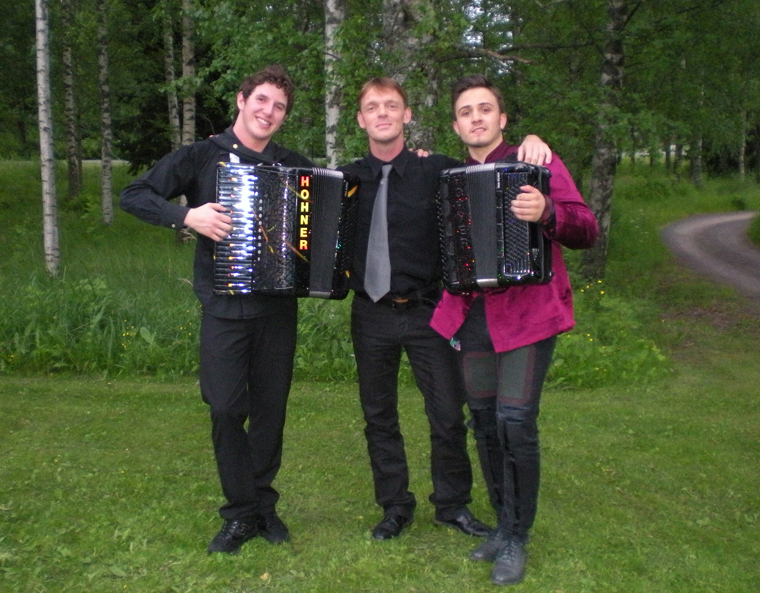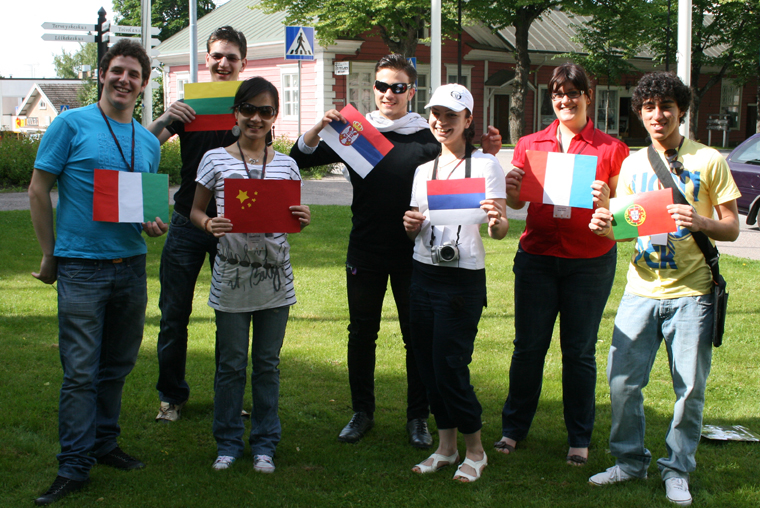|
 |
|
|
|
 |
|
|
|
| |
 |
|
Above:
Winner (left) - Primus Ikaalinen VI Pietro Adragna (Italy)
Runner Up (right) - Petar Maric (Serbia)
with their teacher (center) Frederic Deschamps (France)
|
|
 The
Primus Ikaalinen VI will broadcast online (as well as
live TV Broadcast on National Finnish TV) Thursday 1st
July at 7:15 pm (19.15) (Finnish time). The
Primus Ikaalinen VI will broadcast online (as well as
live TV Broadcast on National Finnish TV) Thursday 1st
July at 7:15 pm (19.15) (Finnish time).
Ikaalinen Hall, Thursday 1st July 2010 at 16.30 (final
rehearsal) and at 19.15 (final competition).
Primus Ikaalinen is an International Accordion Competition
for entertainment music, which brings some of the best
accordionists from all over the world to Ikaalinen.
Primus Ikaalinen competition is for musicians born 1974-1994.
- 1st
Prize - 3000 €
- 2nd
Prize - 2000 €
- 3rd
Prize - 1000 €
- 4th
Prize - 500 €
- 5th
Prize - 500 €
The
6th Primus Ikaalinen International Accordion Competition
will be organized by the Sata-Häme Soi Accordion
Festival and town of Ikaalinen, together with the guidance
of the Finnish Accordion Association, the Confédération
Internationale des Accordéonistes (CIA) and Finland's
National TV Channel TV2, on 1st July 2010. The Competition
Committee will select contestants to the Final in Ikaalinen
from the submitted application documents and recordings.
The contestant must perform two virtuoso entertainment
style pieces of 3-4 minutes in duration suitable for
a public entertainment concert, preferably including
one folkloristic piece from their native country. The
contestant will perform their pieces accompanied by
a band provided by the organizers. The competition will
be televised live on Finland's National TV Channel TV2.
Contestants in the Primus Ikaalinen VI are:
|
|
|
|
|
|
|
|
|
|
|
|
Pietro
Adragna
Firenze, Italy
|
João
Guerreira
Albufeira, Portugal
|
Haiyu
Liu
Sichuan, China
|
Petar
Maric
Belgrade, Serbia
|
|
|
|
|
|
|
|
|
|
|
|
|
Augustinas
Rakauskass
Kaunas, Lithuania
|
Madina
Tsaloeva
Beslan, Russia
|
Sarah
Vonau
Strasbourg, France
|
Winner
of The 2010
Golden Accordion, Finland
|
|
|
|
Members of the International Jury:
Kevin Friedrich, New Zealand (Chairman of the Jury)
Cao Xiaoqing, China
Renzo Ruggieri, Italy
Frederic Deschamps, France
Aleksandr Selivanov, Russia
Pasi Hirvonen, Finland
|
 |
|
Pietro Adragna,
Augustinas Rakauskas, Haiyu
Liu, Petar Maric,
Madina Tsaloeva,
Sarah Vonau, João
Guerreira (Finland candidate will be the winner of the
2010 Golden Accordion Competition
|
 Augustinas Rakauskas - Lithuania (17 years old)
Augustinas Rakauskas - Lithuania (17 years old) |
1. André Astier: La Tempete
2. J. Fina-Z. de Abreu: Bumble Boogie & Tico-Tico
Augustinas Rakauskas comes from Lithuania, a country that
is culturally very rich and has a unique language and
history. The 17-year-old young artist chose the accordion,
because it is a universal instrument that can be used
to play anything from classical baroque music to jazz,
french musette and popular music. He says that the accordion
is also a very practical instrument, since it is a portable
"orchestra" . Augustinas won an Idols-competition
for young talents in Lithuania this year. This is the
first time Augustinas visits Finland but he tells that
he knows how to count from one to ten in Finnish!
As a musician Augustinas would like to achieve something
that hasn't been achieved yet in music. First and foremost
he hopes to be able to bring happiness to people's lives
with his music.
Program Notes: The first piece that Augustinas plays in
Primus Ikaalinen is La Tempete, "The Storm"
by "the father of French accordion music", André
Astier. His second piece is Jack Fina´s Bumble Boogie,
an adaptation of Nikolai Rimsky-Korsakov's "Flight
of the Bumblebee", which is continued with the old
Brasilian song Tico-tico that originates back to 1917
and has become one of the best known hits in the world
through a myriad of recordings and films.
1.
André Astier: La Tempete
2. J. Fina-Z. De Abreu: Bumble Boogie & Tico-Tico
|
 Sarah Vonau - France (21 years old)
Sarah Vonau - France (21 years old) |
|
1. M. Legrand: Les paraplyies de Cherbourg
2. R. Ruggieri: Carnevale
Sarah Vonau (born March 19th,1989) began playing the
accordion when she was 7 years old, under the supervision
of Gabriel Veit. At the age of 12 she met the French
accordion virtuoso Jacques Mornet, and has participated
in Mornet's master classes ever since. Sarah has studied
at Strasburg Conservatory. At the moment Sarah prepares
herself full-time for competitions around the world
at Jacques Mornet 's accordion school and finishes her
degree. Sarah has won many prizes in international competitions,
for example the first prize in the international Klingenthal
Accordion Competition in May this year.
Program Notes: The umbrellas of Cherbourg by Michel
Legrand is one of the most famous pieces of film music
in the world. Sarah performs an arrangement by Jevgeni
Derbenko that makes use of the many technical possibilities
that the accordion provides.
Her second piece is the speedy Carnevale by Renzo Ruggieri,
a piece in which the irresistible swinging rhythmic
patterns carry the catchy melody.
|
 Petar Maric - Belgrade, Serbia (20 years old)
Petar Maric - Belgrade, Serbia (20 years old) |
1. Ferrero: Averse
2. J. Brel: Ne me quittes pas
Petar Maric (born February 28th,1990) has studied classical
music at the Belgrade conservatory with Alexandar Nikolic.
During the past year he has participated the master classes
of Frederic Deschamps around the world. Maric won the
first prize at the Klingenthal International Accordion
Competition in Germany in 2009 and received the best musician
award at Spoleto Spring Festival in Italy in May 2009.
Petar also took part in Primus Ikaalinen last year.
Program Notes: Petar Maric's first piece is NE me quitte
pas, composed by the most renowned character of French
chanson, Jacques Brel. Brel's theme soon transforms into
Serbian Balkango-tango by Maric's teacher Alexandar Nikolic.
The music transports us from France to Serbia, and then
the second piece brings us back from the Balkans to France.
In the second piece the Serbian folk tune Jedna cura mala
("The Little Farm Girl") is followed by the
French accordion piece Averse ("Shower of Rain")
by Maurice Ferrero.
|
 Haiyu Liu - Chengdu, China (23 years old)
Haiyu Liu - Chengdu, China (23 years old) |
1. V. Zubitski: Hommáge a Astor Piazzolla
2. V. Vlasov: Brahms's Smile
Haiyu Liu (born January 5th,1987) comes from Chengdu,
a city of 10 million inhabitants and a three thousand
year old history. Chengdu, located in western China, in
the province of Sichuan, is known as the Panda city of
the world. The accordion is a popular instrument in China
and Haiyu Liu chose it for its beautiful sound. Liu's
first experience of Finland goes back to when she was
a little girl and played a Finnish Polka that her teacher
introduced to her.
Program Notes: Haiyu Liu performs Vladimir Zubitsky's
Hommage á Astor Piazzolla in the first round. It
is an energetic composition that adapts the themes of
Piazzolla. In the piece the artist has to produce
rhythmic patterns in many different ways. In the second
round Liu plays Brahms's smile by Viktor Vlasov. This
piece is motivated by the familiar theme of the Hungarian
Dance number 5 by J. Brahms. Vlasov has adapted a speedy
and technically challenging piece for the accordion.
|
 Pietro
Adragna - Florence, Italy (21 years old)
Pietro
Adragna - Florence, Italy (21 years old) |
1. Luciano Fancelli: After you've gone
2. trad. Dark eyes (arr. Pino di Modugno, Carrara, P.
Adragna)
Pietro Adragna comes from Sicily and studies classical
accordion at the Luigi Cherubino Conservatory in Florence.
He started his studies at the accordion school of Roberto
Fuccelli. Pietro Adragna is a phenomenal virtuoso and
his lively renderings have delighted both audiences and
jurys in many different countries. He has visited Finland
once before. Pietro Adragna has studied variété
music under the instruction of Frederic Deschamps in France.
Pietro also studies the piano, composition and conducting.
Besides having a career as an accordionist, he also wants
to become a conductor.
|
 Madina Tsaloeva - Beslan,
Russia
(23 years old)
Madina Tsaloeva - Beslan,
Russia
(23 years old) |
1. T. Kuliev: Lezcinka
2. trad. Ossetien Fantasy
Madina Tsaloeva (born July 6th,1986) comes from Beslan,
North Ossetia in the Caucasus. She is very proud of her
roots and tells how the nature, culture and history of
North Ossetia make a strong impression on all who visit
the region. Madina plays the Ossetian accordion, an instrument
that is very popular in her home region. It is an instrument
that is meant to be played by women. Madina started her
accordion studies following the old tradition according
to which a woman is as good a bride as her accordion playing
skills. Madina has continued playing the accordion, because
she loves to play. Finland has been a "fairyland"
for Madina when she was a child, because of Santa Claus
and reindeer. Now she says that her childhood dream comes
true when she has the opportunity to visit Finland. At
the moment Madina studies in Moscow. She plays the Caucasian
piano accordion, which differs from the European accordion
both in sound and in the way it looks.
Program Notes: The pieces Madina plays come from North
Ossetia. Her first piece Lezcinka is adapted from a Caucasian
folk tune theme. The melody and the rhythm have familiar
tones and the piece is colored by a shaman-like percussion
background. Madina's second piece is Ossetian Fantasia,
a piece that also has themes originating to ancient Caucasian
folk music. A beautiful melodic beginning leads little
by little to a speedy and fiery ending.
|
 Filipo João Guerreiro - Faro, Portugal (17 years
old)
Filipo João Guerreiro - Faro, Portugal (17 years
old) |
1. trad. Vira do minho (arr. João Frade)
2. Luis Salinas: Para Troilo y Salgan
Filipo João Guerreiro (born December 11th, 1992)
comes from Albufeira in Southern Portugal, a town that
is well known among accordionists. His teacher is João
Frade, a famous Portuguese musician. Filipo tells that
the accordion was the first instrument he played and he
fell in love with it immediately. As a musician his hope
is to create a unique style some day and to become a well
known artist. Now that he visits Finland for the first
time he waits to experience the white nights that he has
heard of.
Program Notes: Vira do Minho comes from the Minho region
in Northern Portugal - Vira is one of the musical styles
of Portugal. So, if this was a Finnish song, it could
be called the Carelian Polka or the Lappish Tango. However,
this arrangement by João Frade is a reckless version
of the Vira that does not have much more in common with
the original Vira than a familiar theme. Guerreiro's second
piece Para Troilo y Salgan is dedicated to two legendary
musicians of the Argentinian tango: Añibal Troilo
(1914-1975) was an Argentinian bandoneonist and conductor
and his contemporary Horacio Salgan (s. 1916) is a pianist
and a conductor. Luis Salinas, the composer of this piece,
is an Argentinian quitarist and one of the most important
names in South American music, especially modern jazz.
This composition is very much in the core of Argentinian
music - this time with a Portuguese flavor.
|
 Finland
Finland |
Winner of the 2010 Golden Accordion Competition
|
|
|
 |
|
www.satahamesoi.fi
|
|
|

